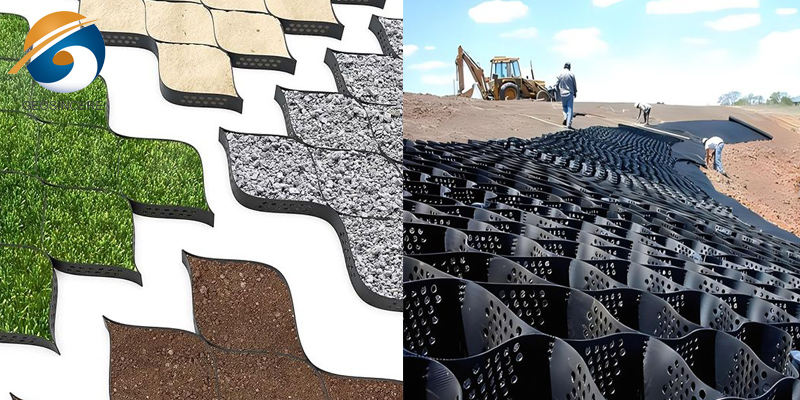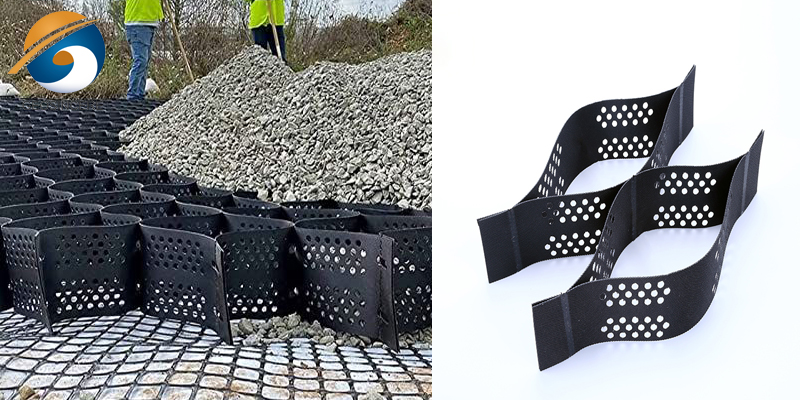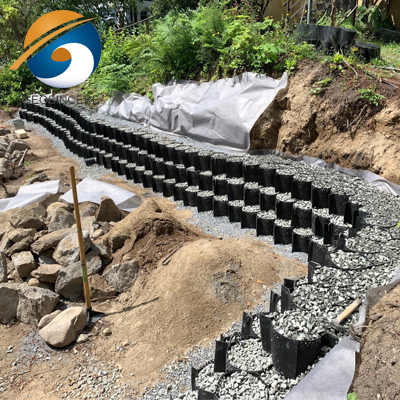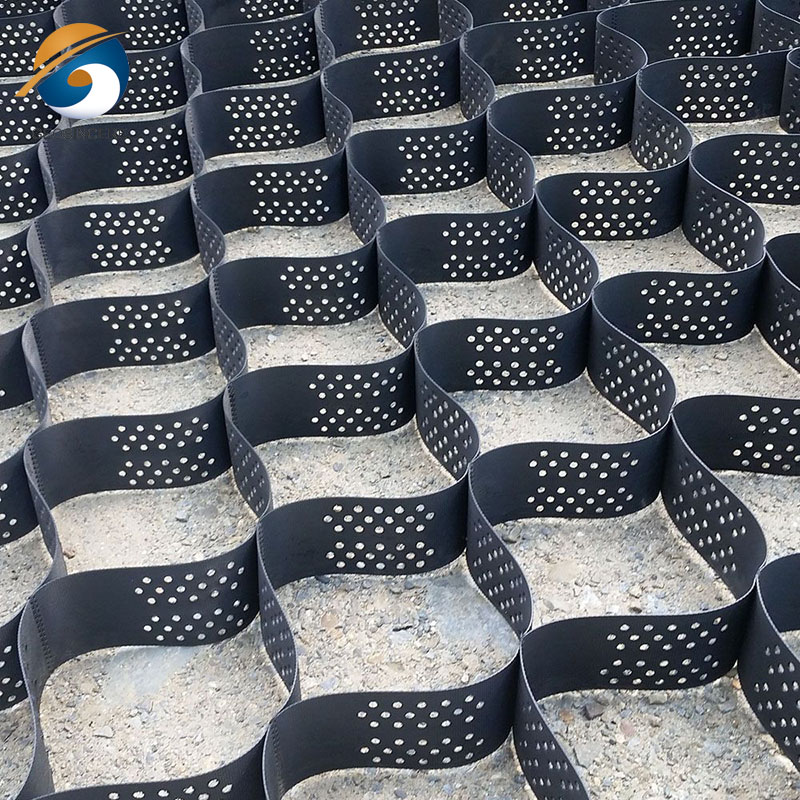What is The Service Life of HDPE Geocell?
How long is the service life of HDPE geocell? This is indeed an important issue worthy of attention in engineering applications. HDPE (high-density polyethylene) is an environmentally friendly and durable material that is widely used in the manufacture of geocells. Generally, HDPE geocells can reach a service life of more than 50 years. This is mainly due to the excellent anti-aging, UV resistance and chemical corrosion resistance of the HDPE material itself. Under the correct design, construction and use conditions, HDPE geocells can maintain good structural integrity and mechanical properties for a long time.
HDPE (high-density polyethylene) geocell is a revolutionary soil reinforcement technology designed to withstand the harshness of the outdoor environment, providing reliable guarantees for engineering quality and safety. The unique honeycomb structure provides enhanced bearing capacity and excellent deformation resistance. This design feature ensures that the reinforcement system remains effective and reliable over an extended service life, making it an ideal choice for various infrastructure and construction projects. In this article, we hope that this information will help you better understand HDPE geocells.
1. What Factors Affect The Long-term Durability of HDPE Geocells Under Different Environmental Conditions?
1.1 UV exposure
HDPE has strong resistance to UV radiation, but long-term exposure to sunlight will still cause a certain degree of degradation over time, cracking and color change.
1.2 Chemical exposure
HDPE has excellent chemical resistance, but exposure to certain acids, strong bases or solvents in soil or groundwater may cause chemical reactions and degradation of HDPE.
1.3 Freeze-thaw cycles
In cold climates, repeated freezing and thawing of soil will put stress on geocells. The ability of HDPE materials to withstand these cycles without cracking or deformation is critical.
1.4 Ambient temperature
Excessive temperature or large temperature fluctuations will accelerate the aging and performance degradation of HDPE materials.
1.5 Microbial degradation
Although HDPE is generally resistant to biodegradation, certain microorganisms may be able to slowly decompose the material over a longer period of time, especially in moist or organic-rich soil conditions.
1.6 Mechanical stress
Extrusion, shearing and other effects during construction or use may cause local damage to HDPE materials.
In order to ensure that HDPE geocells can maintain good durability for a long time under different environmental conditions, these influencing factors need to be fully considered during the design and construction process, and appropriate protective measures need to be taken. Such as blocking ultraviolet rays, using antibacterial agents, setting up isolation layers, etc., to ensure that HDPE materials can play their due functions and performance.
2.How Does The Honeycomb Structure of HDPE Geocells Enhance Their Durability?
The unique cellular structure of HDPE (high-density polyethylene) geocells is a key factor in their long-term durability and performance. This innovative design provides several advantages that contribute to the overall strength and resilience of the geocell system:
2.1 Load distribution
The interconnected honeycomb cells evenly distribute the applied load across the entire surface area of the geocell, reducing stress concentrations at any single point. This load-sharing ability helps prevent localized deformation or failure, even under heavy loads.
2.2 Dimensional stability
The honeycomb structure gives HDPE geocells excellent dimensional stability, allowing them to maintain their shape and integrity even when subjected to environmental factors such as freeze-thaw cycles, soil settlement, or other types of deformation.
2.3 Tensile strength
The cell walls of the honeycomb design have high tensile strength, allowing the geocell to resist pulling and tearing forces that may be generated by soil movement, erosion, or other external stresses.
2.4 Constraint
The interlocking cells of the geocell system help constrain fill materials (such as soil, gravel, or concrete) within the structure, preventing them from washing away or shifting. This constraint enhances the overall stability and load-bearing capacity of the reinforced soil or pavement system.
2.5 Flexibility
Despite its inherent strength, HDPE geocells maintain a degree of flexibility. The honeycomb structure can effectively absorb and disperse material deformation caused by temperature or other environmental factors, reducing stress concentration and local damage.
2.6 Easy installation
The honeycomb design facilitates the rapid and efficient deployment of HDPE geocells, thereby speeding up construction and minimizing disruption to the project site.
By leveraging the unique advantages of honeycomb structures, HDPE geocells are able to provide long-lasting, durable and reliable performance in a wide range of civil engineering applications, including soil stabilization, slope protection and pavement reinforcement.
3.What Protective Measures Need to be Taken to Ensure The Service Life of HDPE Geocells in Harsh Environments?
It should be noted that the actual service life of HDPE geocells is also related to some other factors, such as ambient temperature, pH value, microbial activity, etc. In harsh environments, HDPE (high-density polyethylene) geocells will be affected by extreme conditions and their service life will be shortened accordingly. Therefore, in engineering applications, it is necessary to fully consider the local natural environmental conditions and take necessary protective measures to ensure that HDPE geocells can play a long-term and stable role.
3.1 UV protection
Since long-term exposure to UV rays will cause HDPE materials to degrade over time, sufficient UV protection must be provided. This can be achieved by:
- Covering the geocell with a protective layer, such as soil, gravel or geotextiles.
- Using HDPE geocells with UV-stabilizing additives in the formula.
3.2 Chemical resistance
In order to mitigate the effects of chemical exposure, it is critical to understand the specific soil and groundwater conditions at the project site and select HDPE geocells that are compatible with the current environment. In some cases, it may be necessary to use chemically resistant geomembranes or geotextiles as barriers.
3.3 Insulation
In cold climates, geocells must be able to withstand the stress caused by freeze-thaw cycles. Providing insulation (such as rigid foam or a layer of insulation) helps protect HDPE geocells from the damaging effects of temperature fluctuations.
3.4 Mechanical protection
To protect geocells from abrasion, puncture, or other mechanical stresses, it is recommended to:
- Use protective geotextiles or geomembrane layers below and above the geocell system.
- Ensure proper installation techniques (such as secure connections and anchors) to maintain the integrity of the system.
3.5 Maintenance and monitoring
Regular inspections and minor maintenance (such as repairing any damage or removing accumulated debris) can significantly extend the service life of HDPE geocells in harsh environments.
By taking the above targeted protection measures, the service life of HDPE geocells in harsh environments can be effectively extended, ensuring its long-term stable and reliable performance, thereby maximizing the service life and cost-effectiveness of the reinforcement system.
4.What Are The Common Specific Applications of HDPE Geocells in Infrastructure Projects?
HDPE (High Density Polyethylene) geocells have a wide range of applications in infrastructure projects, and their durability, versatility, and soil reinforcement capabilities make them an excellent choice.
4.1 Slope Stabilization and Erosion Control
- Reinforce steep slopes, embankments, and retaining walls to prevent soil erosion and improve slope stability.
- Prevent landslides, mudslides, and other soil movements in areas prone to natural disasters.
4.2 Pavement Reinforcement
- Stabilize and reinforce road, highway, and airport pavement systems to increase load-bearing capacity and service life.
- Mitigate the effects of soil settlement, freeze-thaw cycles, and other environmental factors that can compromise the integrity of pavement.
4.3 Soil Stabilization and Load Support
- Reinforce weak soil foundations to support structures such as buildings, bridges, and other infrastructure.
- Increase soil bearing capacity in areas with poor soil conditions or high groundwater levels.
4.4 Stormwater Management and Drainage
- Build permeable pavements and drainage systems to manage stormwater runoff and reduce flood risks.
- Stabilize soil around culverts, canals and other hydraulic structures to prevent erosion and maintain their functionality.
4.5 Vegetation reinforcement
- Provide a strong three-dimensional framework to support vegetation growth on slopes, embankments and other earthen structures, enhancing their stability and aesthetics.
- Help establish and maintain healthy vegetation in areas prone to erosion or environmental stress.
4.6 Temporary and emergency applications
- Rapidly deploy HDPE geocells in remote or challenging environments for temporary road construction, access roads and work platforms.
- Emergency reinforcement and stabilization of infrastructure during natural disasters or other unexpected events.
With its excellent mechanical properties, durability and economy, HDPE geocells have broad application prospects in infrastructure fields such as roads, railways, water conservancy, and environmental protection.
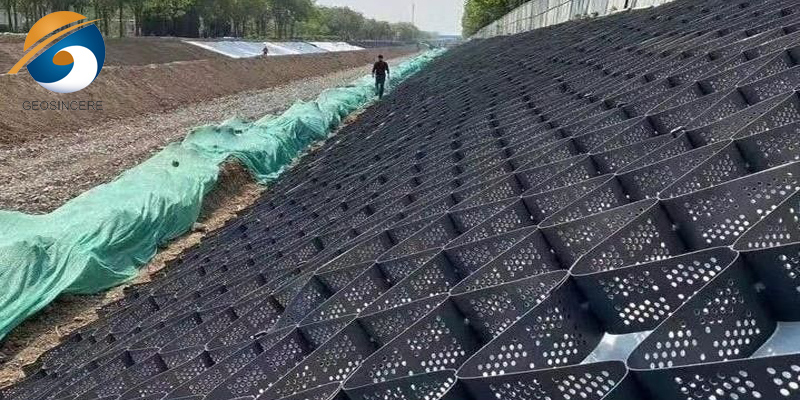
5. Summary
HDPE geocell has a long service life, and its service life can reach 50 years or even longer. This is mainly due to the excellent durability of the HDPE material itself and the unique honeycomb structure design of the HDPE cell. With its excellent durability and reliability, HDPE geocell has been widely used in key projects in infrastructure fields such as roads, railways, water conservancy, and environmental protection, providing strong guarantees for the long-term and stable operation of the project.

